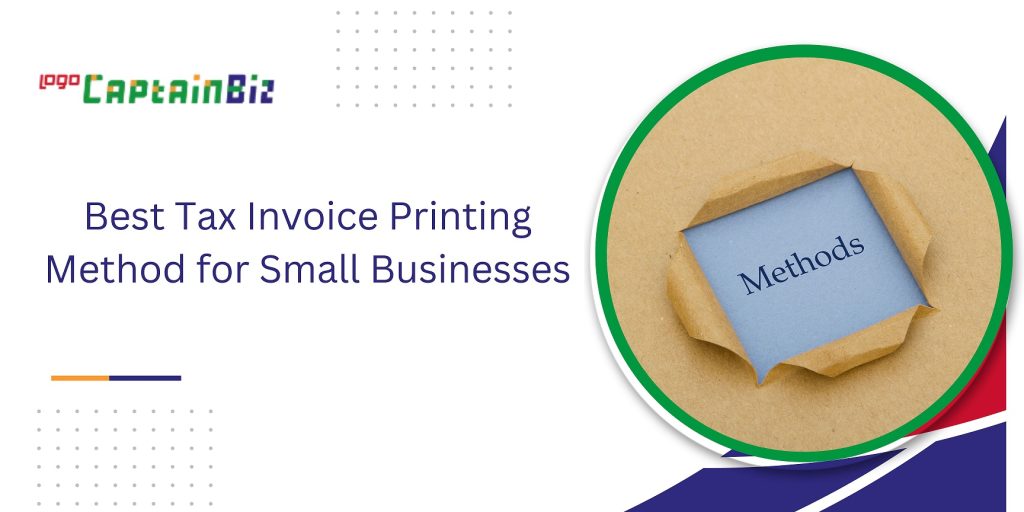In the corporate and financial worlds, tax invoices are essential documentation. They operate as an official record of a transaction and are frequently required for financial management, tax compliance, and accounting. There are several options available to both people and corporations when it comes to preparing tax invoices. Every technique offers a unique set of benefits and drawbacks. This article describes the pros and cons of tax invoice printing methods using a variety of techniques, including handwritten invoices and electronic invoicing (e-invoicing). Businesses may choose the approach that best fits their goals and resources by being aware of these distinctions.
Different Methods for Tax Invoice Printing
There are many different methods of printing a tax invoice, and here are some of them:
1) Manual Handwritten Invoices
Manual handwritten invoices are physical invoices that are created by hand using a pen and paper. They are typically used by small businesses or individuals for simple invoicing needs. They are efficient for businesses that do not have to make high volumes of invoices.
2) Pre-Printed Invoice Forms
Pre-printed invoice forms are actual paper versions of invoice templates that need to have the contents manually filled in. Important invoice data, such as the sender’s and recipient’s identification, item descriptions, quantities, prices, and total amounts, are frequently included in these forms. They provide a more polished appearance in comparison to handwritten invoices.
3) Word or Spreadsheet Format
Digital invoices are often created using word processing (like Microsoft Word) and spreadsheet (like Microsoft Excel) software. It is easy for users to update and store digital copies, add formulas for computations, and customise templates. This approach can still be time-consuming and misses some of the automated capabilities available in specialised accounting software, even if it is more efficient than handwritten or pre-printed invoices.
4) Online Invoicing Software
For preparing and managing invoices, online accounting and invoicing programs provide more sophisticated options. Frequently, they provide customisable choices, automatic computations, and templates. These solutions are a fantastic option for small to big firms since they can manage payments, provide financial reports, and interface with bank accounts and other financial applications.
5) E-Invoicing
The digital production, transmission, and processing of invoices is known as e-invoicing, and it is a paperless invoicing approach. It may include using specialised e-invoicing systems or emailing invoices. E-invoicing expedites the payment processing procedure, minimises mistakes, and is very efficient. It is growing in popularity among all kinds of enterprises. Each one of these approaches has benefits and drawbacks of its own.
Pros and Cons of Invoice Printing Methods
There are advantages and disadvantages to everything, including the method you choose to print your tax invoice. Here are some pros and cons of commonly used ways to print tax invoices:
| Method of Printing | Pros | Cons |
| Manual Handwritten Invoices | This method is cost-effective and quick.
It is suitable for businesses that do not require invoicing a lot. It also adds a personal touch to interactions with customers. |
Manually making invoices increases the risk of eros.
They do not have the professional appearance that a digital invoice might give They are suitable for businesses with a high volume of invoices. |
| Pre-Printed Invoice Forms | These types of invoices give a professional look.
They provide a structural layout for entering information. They can be used repeatedly. |
Pre-printed invoices are not easy to customise.
Changing the format requires ordering new forms, which generates paper waste. |
| Word or Spreadsheet Format | This also gives a professional look to the invoice.
It has room for customisation. It is cost-effective as the software is widely used. |
Designing the templates and putting in the data can take a lot of time.
It requires manual calculations sometimes. |
| Online Invoicing Software | This method is efficient and quite easy to generate tax invoices.
Templates can be customised. Invoices can be generated in digital formats, which is suitable for online sharing. |
Some software comes with high subscription fees.
It might take a little time to learn and get used to the software. It requires an internet connection to access the software |
| E-Invoicing | E-invoicing saves the environment, uses less paper, and allows invoices to be sent and received instantly.
Digital records are convenient to organise, store, and retrieve. It is appropriate for cross-border commerce. |
There may be a need for initial integration and setup.
Technology and an internet connection are prerequisites. Advanced data security procedures are required to safeguard private financial data. |
Which Tax Invoice Printing Method Should You Choose?
Your unique business demands, the number of transactions, and the resources at your disposal should all be taken into consideration when selecting a tax invoice printing technique. Using online accounting and invoicing software might be an economical and effective alternative if your small business has relatively minimal billing requirements.
This approach makes it possible to customise, professionally brand, and handle bills more efficiently. It’s especially appropriate if you wish to go from manual to automated invoicing procedures that are more polished. On the other hand, integrated accounting and invoicing solutions can be more suitable if you work for a larger company with substantial invoicing requirements.
These systems provide easy record-keeping, cutting-edge functionality, and interaction with more comprehensive financial procedures. E-invoicing is a sustainable and effective option for companies that deal internationally, as it allows for fast invoice transmission and conformity to international standards. The secret is to assess your company’s size, technical skills, and operational needs before selecting the tax invoice printing option that best fits your particular set of circumstances.
Best Tax Invoice Printing Method for Small Businesses

For small firms, the most effective way to print tax invoices generally relies on their unique requirements and available resources. Online accounting and invoicing software is frequently the best option. These cloud-based systems provide simple payment tracking, effective computation automation, and configurable invoice templates.
They are easy to use and give invoices a polished appearance, which is essential for small firms trying to project a polished image to clients. Additionally, digital invoices produced using online accounting and invoicing software may be stored and shared online, helping to ensure that tax laws are followed.
Premium software may have subscription costs, but these are frequently offset by the advantages in terms of efficiency, accuracy, and ease of accessing and managing financial information. Online accounting and invoicing software may be a useful and affordable option for small firms trying to maintain tax compliance while streamlining their invoicing process.
Best Tax Invoice Printing Method for Exporters
The most effective way for exporters to print tax invoices should be in line with the efficiency demands of this particular industry as well as worldwide trade norms. Exporters would do well to go for e-invoicing. Electronic invoicing saves money and the environment by using less paper and fewer resources. Importantly, they make it easier for exporters who deal with time-sensitive shipments to provide invoices to overseas clients and customs officials quickly.
Digital invoices are a need in international trade where precise records are crucial as they are simple to save, retrieve, and arrange for auditing and compliance purposes. E-invoicing platforms may also be easily coupled with other export-related software, which expedites the export procedure in its entirety.
Exporters attempting to negotiate the intricacies of international commerce will find that e-invoicing is the best option in the long run due to its efficiency, accuracy, and compliance with international invoicing requirements, even though there may be an initial setup cost.
Conclusion
A key component of corporate operations is invoicing, and the technique used to generate tax invoices may have a big influence on compliance, accuracy, and efficiency. What is best is that it depends on the particular requirements and available resources of the organisation creating the bills. Although manually prepared bills are simpler, they can be laborious and prone to mistakes. Although they look more professional, pre-printed invoice forms are not automated. Spreadsheet and word processing tools can be customised, but they might not make the process more efficient. While accounting software and online invoicing provide many organisations with all-inclusive solutions, e-invoicing is the pinnacle of efficiency and automation.
In the end, the choice should be influenced by elements including the quantity of invoices, the intricacy of the transactions, financial limitations, and the need for efficiency. Selecting a tax invoice printing technique that fits the overall financial and operational objectives of the company or person, in addition to complying with legal requirements, is crucial. Even though more companies are switching to electronic invoicing as technology develops, old techniques are still useful in some situations. Finding the strategy that best balances cost-effectiveness, professionalism, and convenience is crucial. For more information regarding the advantages and disadvantages of tax invoice printing methods, visit CaptainBiz.
FAQs
Q1: Are printed invoices better than electronic documents?
Tax obligation calculations and record keeping are done using printed invoices. When compared to electronic papers, printed documents are simpler to read. The cost of printing an invoice is one. Spending money on a printer and toner is necessary. However, the cost of electronic papers is far lower than that of printed ones.
Q2: What are the disadvantages of an e-invoicing system?
The lack of an archiving option on IRP is a drawback. It is not required to keep invoices on file for more than 24 hours.
Q3: What are the benefits of e-invoicing?
Input tax credit (ITC) availability is facilitated by this. When using e-invoicing, a taxpayer only has to submit the invoice once and have it verified by the Invoice Registration Portal (IRP), which subsequently issues the Invoice Reference Number (IRN) after validating the invoice.
Q4: What is printing invoices?
A commercial document called an invoice is used to document transactions between buyers and sellers. One conventional method of documenting a sale transaction is to print an invoice. A copy of the invoice is sent to the customer as a reminder of the items sold or, if applicable, the service done.
Q5: Why is it crucial to receive a tax invoice?
Tax invoices must be issued in order to prove that products or services were provided. At the moment of supply, all registered GST taxpayers are required to provide a tax invoice. In order to claim the input tax credit, a buyer must provide a tax invoice for any products or services they have acquired.

